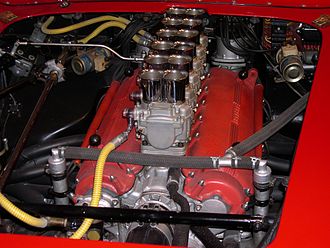Inlet manifold




Inlet manifold or intake manifold is a component of an internal combustion engine that supplies the fuel/air mixture to the cylinders. The design and function of the inlet manifold are crucial for the engine's performance, efficiency, and emissions. The manifold typically consists of a series of tubes or passages that distribute the air or air/fuel mixture from the throttle body to the individual cylinders. In some engines, the manifold can also serve as a mount for the fuel injectors.
Design and Function[edit]
The design of the inlet manifold can significantly influence the performance of an engine. It must efficiently distribute the air or air/fuel mixture to each cylinder, ensuring that each receives an equal amount of the mixture. This distribution is critical for the engine's smooth operation and optimal performance. The manifold's design, including its length, diameter, and shape of the passages, can affect the engine's power and torque characteristics.
In addition to distribution, the inlet manifold can also affect the engine's air charge temperature. Cooler air is denser and can lead to a more efficient combustion process. Some manifolds are designed with features to help cool the incoming air, or they may be made from materials that help reduce heat transfer from the engine.
Modern engines may use variable length intake manifold (VLIM) technology, which can change the length of the intake tract depending on engine speed and load. This technology helps optimize performance and efficiency across a broader range of operating conditions.
Materials[edit]
Inlet manifolds can be made from various materials, including aluminum, cast iron, and composite materials. Aluminum manifolds are lightweight and have good thermal properties, which can help reduce heat transfer to the air/fuel mixture. Cast iron manifolds are very durable but heavier and can retain more heat. Composite materials, such as plastics, are used in modern engines for their light weight and low heat conductivity, which helps keep the air charge cooler.
Maintenance and Issues[edit]
Over time, inlet manifolds can develop issues such as leaks, cracks, or buildup of deposits, which can affect engine performance and efficiency. Leaks in the manifold can lead to an incorrect air/fuel ratio, causing the engine to run lean or rich. This can result in reduced power, increased emissions, and potential damage to the engine. Regular inspection and maintenance are important to ensure the manifold is in good condition and functioning properly.
Environmental Impact[edit]
The design and operation of the inlet manifold can also have an impact on the engine's emissions. Efficient distribution of the air/fuel mixture and maintaining a cooler air charge can help improve combustion efficiency, reducing harmful emissions. Advances in manifold design and materials continue to contribute to cleaner and more efficient engines.

This article is a automobile-related stub. You can help WikiMD by expanding it!
Ad. Transform your life with W8MD's Budget GLP-1 injections from $75


W8MD offers a medical weight loss program to lose weight in Philadelphia. Our physician-supervised medical weight loss provides:
- Weight loss injections in NYC (generic and brand names):
- Zepbound / Mounjaro, Wegovy / Ozempic, Saxenda
- Most insurances accepted or discounted self-pay rates. We will obtain insurance prior authorizations if needed.
- Generic GLP1 weight loss injections from $75 for the starting dose.
- Also offer prescription weight loss medications including Phentermine, Qsymia, Diethylpropion, Contrave etc.
NYC weight loss doctor appointmentsNYC weight loss doctor appointments
Start your NYC weight loss journey today at our NYC medical weight loss and Philadelphia medical weight loss clinics.
- Call 718-946-5500 to lose weight in NYC or for medical weight loss in Philadelphia 215-676-2334.
- Tags:NYC medical weight loss, Philadelphia lose weight Zepbound NYC, Budget GLP1 weight loss injections, Wegovy Philadelphia, Wegovy NYC, Philadelphia medical weight loss, Brookly weight loss and Wegovy NYC
|
WikiMD's Wellness Encyclopedia |
| Let Food Be Thy Medicine Medicine Thy Food - Hippocrates |
Medical Disclaimer: WikiMD is not a substitute for professional medical advice. The information on WikiMD is provided as an information resource only, may be incorrect, outdated or misleading, and is not to be used or relied on for any diagnostic or treatment purposes. Please consult your health care provider before making any healthcare decisions or for guidance about a specific medical condition. WikiMD expressly disclaims responsibility, and shall have no liability, for any damages, loss, injury, or liability whatsoever suffered as a result of your reliance on the information contained in this site. By visiting this site you agree to the foregoing terms and conditions, which may from time to time be changed or supplemented by WikiMD. If you do not agree to the foregoing terms and conditions, you should not enter or use this site. See full disclaimer.
Credits:Most images are courtesy of Wikimedia commons, and templates, categories Wikipedia, licensed under CC BY SA or similar.
Translate this page: - East Asian
中文,
日本,
한국어,
South Asian
हिन्दी,
தமிழ்,
తెలుగు,
Urdu,
ಕನ್ನಡ,
Southeast Asian
Indonesian,
Vietnamese,
Thai,
မြန်မာဘာသာ,
বাংলা
European
español,
Deutsch,
français,
Greek,
português do Brasil,
polski,
română,
русский,
Nederlands,
norsk,
svenska,
suomi,
Italian
Middle Eastern & African
عربى,
Turkish,
Persian,
Hebrew,
Afrikaans,
isiZulu,
Kiswahili,
Other
Bulgarian,
Hungarian,
Czech,
Swedish,
മലയാളം,
मराठी,
ਪੰਜਾਬੀ,
ગુજરાતી,
Portuguese,
Ukrainian